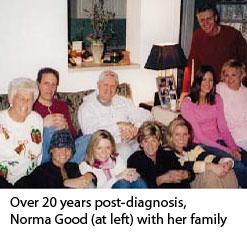
A grim prognosis
In 1989, all three of Norma Good’s blood counts were found to be abnormally low. The hematologist in her home town admitted to not knowing how to handle her rare bone marrow failure condition, so he referred to her to a local clinic which didn’t offer much hope for survival. Not easily deterred, Norma sought out a clinical trial at the National Institutes of Health (NIH) in Bethesda, Maryland. “The NIH is wonderful,” she says. “They’re doing their best to combat these diseases, and they’re making improvements all the time. We need to encourage people to realize how much better things are now.”
Norma’s initial diagnosis had been aplastic anemia, but 18 months later, her diagnosis was changed to MDS. She searched for information about her extremely rare condition. AA&MDSIF was a relatively new organization in the 1980s, but it provided her with support. “The people at AA&MDSIF were wonderful. There was a local chapter near where I lived in Cleveland, and some caregivers for another patient were very supportive of me as well,” says Norma.
A long battle
Over the three and half years after her diagnosis, Norma battled her low blood counts with several treatments. Throughout the process, she received blood transfusions every seven to ten weeks. She had over ninety transfusions altogether, each with 1-4 units. Initially, she received both platelets and red cells, but after three months she was given only red cells.
The first treatment Norma tried was antithymocyte globulin (ATG). She experienced serum sickness from the treatment, consisting of a rash and fever. But she says, “I don’t want to scare anyone. It wasn’t pleasant as it was put into the body, but it only took about eight hours, so it wasn’t too bad.” However, ATG proved to be ineffective for her.
Norma’s next treatment was a growth factor protocol. She received three growth factor treatments over the following three years. The fi rst growth factor treatment was GM-CSF (Leukine®). This treatment made her feel extremely sick, with after effects that were similar to chemotherapy. She says, “The most difficult thing about it was deciding to continue the protocol after the extreme sickness I experienced with the treatment.”
However, Norma was unwilling to give up, so she spent eight weeks at the NIH receiving another growth factor treatment, interleukin-3 (IL-3). After these eight weeks, she received treatment with G-CSF (Neupogen®). She experienced no major side effects from what was to be her final treatment. After more than three years of undergoing treatments, her blood counts started to rise, and she finally went into remission.
A different battle
In addition to her medical issues, Norma faced continuous problems with her insurance. She was forced to change her hospitalization plans three times during her treatments. She also turned 65 during this time, which constituted further changes for her insurance. Fortunately, she didn’t have to pay for medications while enrolled in the NIH trial, and social workers at NIH helped her navigate her insurance problems.
Norma also found support in her husband, who stayed by her side throughout the entire ordeal. In the three and half years before she went into remission, she was able to maintain a fairly normal life. During her treatments, she found substitute teachers to teach her classes, and between treatments she went to work every day, scheduling her blood transfusions around her regular work hours.
There is a tomorrow
Norma has been in remission for eighteen years. She has become an active speaker for her local blood bank. Her slogan is, “There is a tomorrow—and there is a tomorrow because you’ve given blood.” Her message is that if people hadn’t taken the time to give blood, she wouldn’t be able to be here. As she tells people, “It’s scary when there’s a shortage of blood and you depend on it.”
Norma’s advice to other patients is to not be shy about seeking help. “When AA&MDSIF asks if you want a volunteer to call you, LET them call you. It helps to talk to someone who’s been through it.”
She also advises people to be patient, and above all, to have faith. “After two years of treatment, I didn’t think that things were going to ever change, but after three and a half years, it finally turned,” says Norma. “You have to say I WILL get through this. I want to live. The fact that I’m still here after 22 years speaks to the fact that you can survive this disease.”

